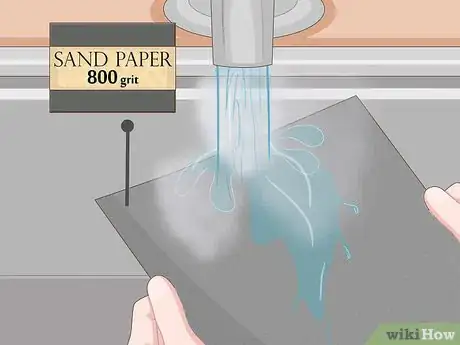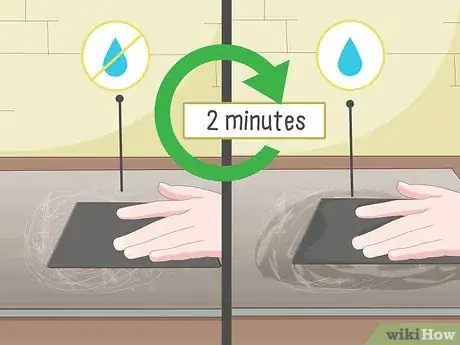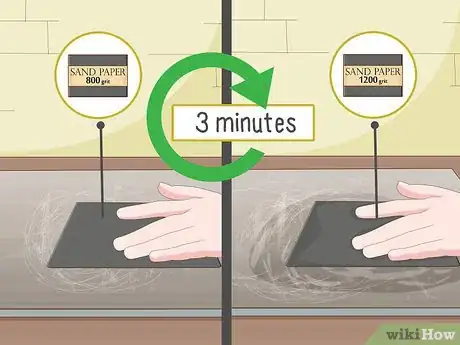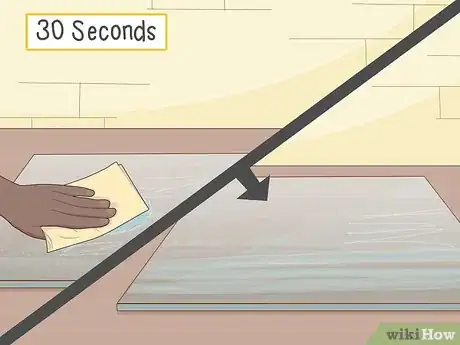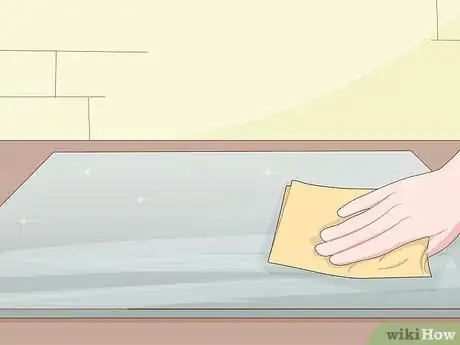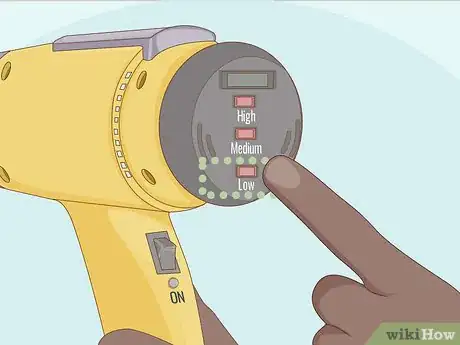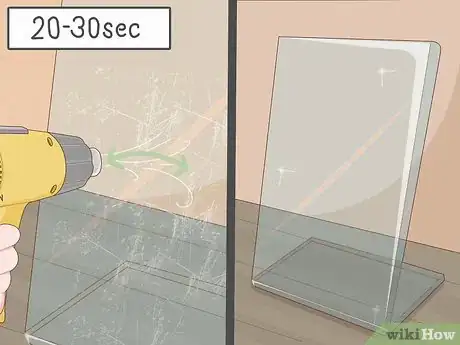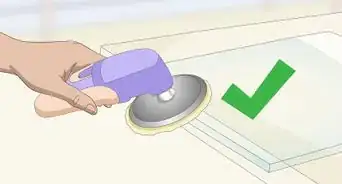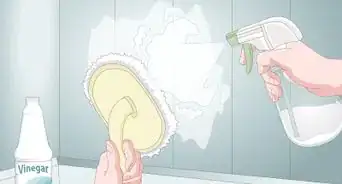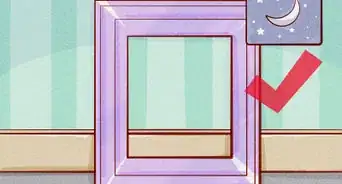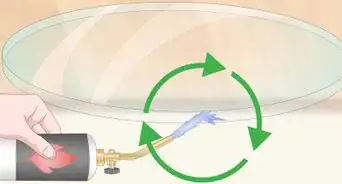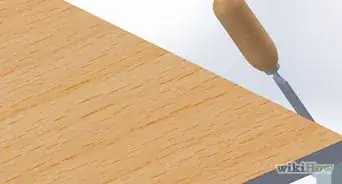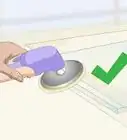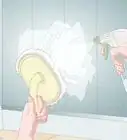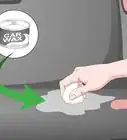This article was co-authored by Claudia & Angelo Zimmermann and by wikiHow staff writer, Hunter Rising. Claudia and Angelo Zimmermann are the founders of Everneat, an Eco-Friendly Cleaning Service based in New York City and in Connecticut. They are also the founders of Clean Code, a DIY 100% natural cleaning product line.
There are 9 references cited in this article, which can be found at the bottom of the page.
This article has been viewed 102,579 times.
Plexiglass, or acrylic plastic, is a common material used on headlights and vehicles since it's shatter-resistant. However, it can easily get scratched and damaged. If you have deep scratches in your plexiglass, you may have to use sandpaper to remove them. Otherwise, you can easily get rid of surface-level scratches with a commercial remover product or a heat gun. No matter which way you get rid of them, your plexiglass will look like new when you're finished!
Steps
Sanding Away Scratches
-
1Wet a piece of 800-grit sandpaper. Run a piece of 800-grit sandpaper underneath warm water to get it damp. Shake any excess water off of the piece and wring it out so it doesn't drip. Set up your work station near a sink if possible so you can re-wet the sandpaper whenever you need to.[1]
- If you have a deep scratch on your plexiglass, then start with 600-grit sandpaper instead.
Tip: Run your fingernail over the scratch perpendicularly. If your nail falls into the scratch and catches, then it's considered a deep scratch. If your fingernail goes over the scratch, then it's light.
-
2Sand over the scratch in small circles for 1 minute. Apply light pressure to the scratches with your wet piece of sandpaper. Work in small, circular movements to buff the surface evenly. Sand any areas that are scratched for 1 minute, and wet the sandpaper again when it feels dry.[2]
- Your piece of plexiglass may start to look cloudy or frosted over, but it will not stay that way when you finish.
Advertisement -
3Alternate between a dry and wet piece of sandpaper for the next 2 minutes. Switch to a dry piece of 800-grit sandpaper and go over the same areas. Keep working in small circles so the scratch is buffed completely. After about 30 seconds, switch back to using wet sandpaper. Change the sandpaper you're using every 30 seconds for the next 2 minutes.[3]
- Alternating between wet and dry sandpaper creates more abrasion and helps work through the scratches faster.
-
4Switch to working with wet and dry 1,200-grit sandpaper. Once you've worked with 800-grit sandpaper, switch to 1200-grit, which will help smooth your plexiglass even more. Start with a wet piece of sandpaper for 30 seconds and then switch to a dry piece. Keep alternating between wet and dry sandpaper for 3 minutes to buff the plexiglass.[4]
-
5Apply a thin layer of plexiglass polish to the area. The area with the scratches will look cloudy when you're finished buffing it with the sandpaper. Apply a coin-sized amount of plexiglass polish onto a clean cloth and work it into the glass in small circular motions. Keep buffing the polish for 30 seconds or until it turns clear on your surface. Wipe the polish off with a clean, dry cloth to remove the scratches.[5]
- You can buy plexiglass polish from your local hardware store.
- Plexiglass polish may also be called acrylic polish in stores.
Polishing with a Commercial Scratch Remover
-
1Wet a soft cleaning cloth with warm water. Use a cleaning cloth made of a soft material, such as cotton or microfiber.[6] Run the cleaning cloth under warm water until it's completely saturated. Wring the cloth out so it isn't dripping wet when you use it.[7]
- Don't use a cloth that has an abrasive side since it will only add more scratches to your plexiglass.[8]
-
2Apply a coin-sized amount of scratch remover onto your rag. Acrylic scratch removers, such as Novus or Turtle Wax, help polish your plexiglass and buff out any light scratches on its surface. Squeeze a dime-sized amount onto the damp cloth, and rub it into the cloth to spread it. If you have multiple scratches you need to remove, use a quarter-sized amount instead.[9]
- You can buy scratch remover in hardware and big box stores.
- You may also apply the scratch remover directly on the plexiglass if you want.
-
3Buff the remover into the scratch for 30 seconds with your cloth. Move the cloth in small, circular motions to work the scratch remover into the scratch. Evenly coat the scratch as much as you can to fill and blend it in with the rest of the plexiglass. Keep buffing the remover for at least 30 seconds or until it turns clear.[10]
-
4Wipe the scratch remover off the plexiglass with a dry cloth. As soon you're done applying the scratch remover to the plexiglass, use a lint-free cleaning cloth to wipe any excess off. Work in small circles over the surface of your plexiglass. Once the scratch remover is off of your piece, you won't be able to see the scratches anymore.[11]
- Hold your plexiglass up to a light to see if there are any visible scratches. If there still is, then buff on another coat of scratch remover.
Heating Shallow Scratches
-
1Set your heat gun to the lowest setting. Plug in your heat gun and look for the buttons or dial on the side that control the temperature settings. Press the arrow buttons or turn the dial to set it to the lowest heat setting available.[12]
- You can buy heat guns from your local hardware store.
- Many heat guns will automatically start on the lowest heat setting when they're turned on.
-
2Hold the heat gun 2–3 in (5.1–7.6 cm) from the plexiglass and turn it on. Position the plexiglass so you can easily reach the scratch with your heat gun. Keep the heat gun's nozzle at least 2 inches (5.1 cm) from the plexiglass so you don't accidentally cause it to melt or bubble. When you're ready to start, press the power button to start the machine.[13]
- Make sure the plexiglass is sitting on a heat-safe surface since the heat gun will make it very warm.
Warning: Never point the heat gun at another person or anything flammable since it will be very hot.
-
3Work back and forth across the scratch until it disappears. Keep the heat gun moving over the scratch while you use it so you don't cause the plexiglass to melt or bubble. Use small back and forth strokes over the entire scratch until it starts to disappear. Try adjusting the angle of the heat gun to hit the scratch from all sides. After about 20-30 seconds of heating, light scratches will start to go away. [14]
- Using a heat gun does not work on deep scratches.
Expert Q&A
Did you know you can get expert answers for this article?
Unlock expert answers by supporting wikiHow
-
QuestionHow do you clean plexiglass?
 Claudia & Angelo ZimmermannClaudia and Angelo Zimmermann are the founders of Everneat, an Eco-Friendly Cleaning Service based in New York City and in Connecticut. They are also the founders of Clean Code, a DIY 100% natural cleaning product line.
Claudia & Angelo ZimmermannClaudia and Angelo Zimmermann are the founders of Everneat, an Eco-Friendly Cleaning Service based in New York City and in Connecticut. They are also the founders of Clean Code, a DIY 100% natural cleaning product line.
House Cleaning Professionals Plexiglass is delicate and very easy to scratch, so you want to remove any particles from the surface first. Use a dry dust microfiber cloth to dust the surface very softly. This specialty cloth attracts dust like a magnet. Then, fold your glass microfiber cloth in 4 and spray glass cleaner directly to the surface. Wipe it down and then remove any marks or streaks with the dry side of your cloth.
Plexiglass is delicate and very easy to scratch, so you want to remove any particles from the surface first. Use a dry dust microfiber cloth to dust the surface very softly. This specialty cloth attracts dust like a magnet. Then, fold your glass microfiber cloth in 4 and spray glass cleaner directly to the surface. Wipe it down and then remove any marks or streaks with the dry side of your cloth.
Warnings
- Some deeper scratches may not be completely removable, but they may be made less noticeable.⧼thumbs_response⧽
Things You'll Need
Sanding Away Scratches
- 800-grit sandpaper
- 1,200-grit sandpaper
- Cleaning cloth
- Plexiglass or acrylic polish
Polishing with a Commercial Scratch Remover
- Cleaning cloths
- Scratch remover
Heating Shallow Scratches
- Heat gun
References
- ↑ https://www.diydaddyblog.com/the-plastic-people-how-to-remove/
- ↑ https://www.diydaddyblog.com/the-plastic-people-how-to-remove/
- ↑ https://www.diydaddyblog.com/the-plastic-people-how-to-remove/
- ↑ https://www.diydaddyblog.com/the-plastic-people-how-to-remove/
- ↑ https://www.diydaddyblog.com/the-plastic-people-how-to-remove/
- ↑ Claudia & Angelo Zimmermann. House Cleaning Professionals. Expert Interview. 12 July 2019.
- ↑ https://youtu.be/TpZBpwauAUk?t=95
- ↑ Claudia & Angelo Zimmermann. House Cleaning Professionals. Expert Interview. 12 July 2019.
- ↑ https://youtu.be/TpZBpwauAUk?t=104
